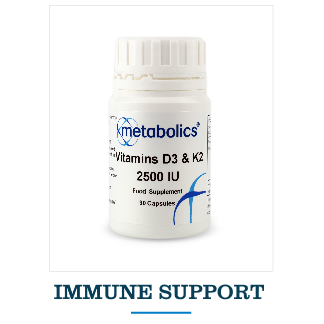Vitamin A is essential for all mammals. Preformed vitamin A is a group of fat-soluble compounds of animal origin called retinoid. It is found in eggs, milk products and animal liver. In countries low in foods derived from animals, carotenoids from vegetables need to supply the requirements for Vitamin A. In Asia and in Africa this can be 80% of the dietary intake whilst in the Western diet, as much as 40% of dietary intake.
Alpha and beta-carotene can be converted to Vitamin A by an enzyme in the small intestine. Dietary preformed Vitamin A is absorbed in the upper part of the small intestine in a similar manner to fat absorption. Short chain retinal esters are hydrolysed by pancreatic lipase and long chain retinal esters by an enzyme in the cells of the small intestine. The released vitamin A (Retinol) is absorbed into the small intestine cells where it becomes bound to a protein (Retinol binding protein 2). This intracellular retinol is re-esterified and packaged into chylomicrons in the lymphatic system and then released into the general circulation. The chylomicrons are then hydrolysed by lipoprotein lipase and taken up by the tissues, usually by specific receptors, particularly in the liver, where it is stored.
Intracellular retinol is converted to retinal and then to retinoic acid and catalysed by alcohol dehydrogenase enzymes. These enzymes act as regulators of tissue retinoic acid levels.
Vitamin A Benefits And What It Does
Vitamin A contributes to the maintenance of normal vision. Vitamin A as retinol combines with the protein opsin to form rhodopsin, a light sensitive visual pigment. Rhodopsin is situated in the parts of the eye responsible for low light, peripheral vision and colour vision. Deficiency of Vitamin A prevents the normal production and re synthesis of rhodopsin, causing night blindness.
Vitamin A contributes to the maintenance of normal skin. Once retinol has been converted to retinoic acid, this acts as an important hormone like growth factor for epithelial cells. Deficiency may produce a keratinizing metaplasia of epithelial cells with resultant keratosis. This means the normal epithelial skin cells (and epithelial cells of the eye) lose their moisture, atrophy or die and are replaced by stratified harder thicker horny cells. The basal cells that normally maintain the integrity of the epithelium respond to Vitamin A deficiency by increasing their division and proliferating, undermining and replacing the original epithelium with increased keratin.
Vitamin A has a role in the process of cell specialisation. As mentioned above, Vitamin A has an effect on the end stage differentiation of human keratinocytes. As a small hydrophobic molecule retinoic acid diffuses directly across the plasma membrane and is able to bind to specific nuclear receptors, which then are able to bind to specific elements on DNA, thus regulating Gene expression. It even regulates the expression of the gene for Growth Hormone Both Retinol and Retinoic acids are essential for specialisation of cells for limb development and formation of the ears, eyes and heart.
Vitamin A contributes to the normal development and function of the immune system. Retinol and Retinoic acid are involved in the normal development and specialisation of the white blood cells such as lymphocytes. T lymphocytes (killer T cells and helper T cells) are activated by retinol binding proteins. Killer T cells hunt and destroy cells infected or cancerous cells.
Vitamin A contributes to normal iron metabolism. Vitamin A supplements has been shown to reduce iron deficiencyanaemia better than using iron supplementation of Vitamin A supplementation alone.
Randomised double blind placebo controlled studies showed that in a group of 251 iron deficient pregnant ladies given supplementation for 8 weeks, the proportion of women who became non anaemic was 35% in the Vitamin A supplemented group , 68% in the iron supplemented group and 97% in the group supplemented with both and 16% in the placebo group. It has been hypothesised that Vitamin A may be required for Transferrin synthesis and iron release from the liver.
Vitamin A Contributes to the maintenance of normal mucus membranes. Cellular differentiation is the central mechanism explaining the effect of Vitamin A on epithelial barriers. Retinol and its metabolites maintain the integrity and function of these epithelial cells. Vitamin A deficiency can result in the absence of mucus secreting goblet cells. Studies carried out in infants supplemented with retinyl palpitate demonstrated improved gut integrity.
Important Information About Vitamin A
Care should be taken with preformed Vitamin A supplements as amounts taken above the UL (Tolerable Upper Intake Level) may be toxic or unsafe. The UL for 19 years or older for males and females is 3000mcg / day (This equals 10,000 IU). Levels above this should only be taken with medical supervision. It is a safer option to take Vitamin A in the form of Carotinoids and let the body do the converting to Vitamin A.
Metabolics mixed Carotinoids (no longer sold) are a combination formula containing alpha and beta-carotene, Lycopene and zeaxanthin. Both alpha and beta-carotene can only be synthesised by plants and are only soluble in fats.
They are provitamins being safe biological precursors of Vitamin A (Retinol) they differ in the position of the double bond in their ring structure. Alpha carotene is found in fruits and vegetables such as leafy green, avocados broccoli and green beans.
The more orange the vegetable, the greater the amount of beta-carotene, such as in carrots. Carotenoids are converted in the body to Vitamin A as a regulated process protecting the body from excessive vitamin A intake that can be toxic. The other carotenoids contained in this formula are Lycopene and zeaxanthin.
Lycopene is a bright red carotenoid found in tomatoes and other red fruits and vegetables. After it is ingested Lycopene is incorporated into the lipid micelles in the small intestine allowing the fat-soluble carotenoid to be absorbed effectively. It is found predominantly in the liver, kidneys, adrenals and testes.
Zeaxanthin is also a carotenoid found in many vegetables and marigold flowers. Zeaxanthin is one of the two major components of the macular pigment of the retina and the lens of the eye.
Symptoms Of Vitamin A Deficiency
- Night blindness- where it is difficult to see in dim light
- Dry Eyes (xerophthalmia)
- Blindness
- Inhibits growth and development of the foetus- birth defects
- May make iron deficiency anaemia worse
- Epithelial changes of the skin – xeroderma of skin – dry and scaly skin with itching (hyperkeratosis)
- Phrynoderma (Toad skin) where follicle like goose pimples appear on skin and sweat glands become blocked with plugs of keratin
- Bronchi of lungs may become dry and rough and prone to infection
- Changes in any system with mucus membranes, such as susceptibility to intestinal infection due to decreased mucus and barriers, changes in the reproductive tract, possible dry vagina and vaginitis
- Changes in bone structure due to irregular development
- Lowered resistance to infection
Symptoms of Vitamin A Toxicity
- Birth defects
- Nausea, headache, dizziness, dry skin, dry, itchy, cracking skin.
- Bone and joint pain or osteoporosis
- Severe toxicity can result in eye damage
- Intrahepatic cholestasis where bile cannot flow from liver to the intestines
If you are experiencing any of the following symptoms I would advise your speak to your local doctor or GP, who will be able to asses you further.
I hope you've found this post useful and If you have any specific questions relating to Vitamin A, I'd be delighted to answer them in the comments section below.



